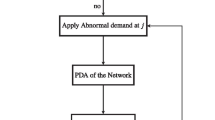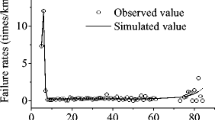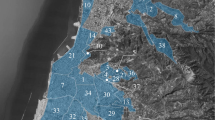Abstract
Maximum pressure is a crucial factor in pipe break events. In this paper, a field data-based methodology is proposed to statistically investigate the relationship between operating pressures and pipe break rates in water distribution networks. The objective is to develop the pipe break rate functions (BRFs) where a maximum pressure indicator (MPI) is associated with an average level of pipe break rates. The methodology uses measured pressure values at the average zone point to calculate MPIs along with recorded pipe breaks to establish BRFs for different pipe materials. The Bayes theorem is then applied to identify the maximum pressure thresholds on the BRFs by means of the unconditional and break- conditioned cumulative distribution functions of the MPIs. The methodology is applied to a large zone of the water distribution network of Tehran (Iran). The results showed that the annual average of the MPI is the best indicator to develop BRFs. The obtained pressure thresholds confirm that the break rates increase rapidly for specific maximum pressure ranges, which can be used to implement effective pressure management.







Similar content being viewed by others
References
Al-Barqawi H, Zayed T (2006) Condition rating model for underground infrastructure sustainable water mains. J Perform Constr Facil 20:126–135. https://doi.org/10.1061/(ASCE)0887-3828(2006)20:2(126)
AWWA (2009) Water audits and loss control programs - manual of water supply practices, 3rd ed. Denver
Babovic V, Keijzer M, Hansen PF (2002) A data mining approach to modelling of water supply assets. Urban Water J 4:401–414
Berardi L, Giustolisi O, Kapelan Z, Savic DA (2008) Development of pipe deterioration models for water distribution systems using EPR. J Hydroinf 10:113–126. https://doi.org/10.2166/hydro.2008.012
Creaco E, Walski T (2017) Economic analysis of pressure control for leakage and pipe burst reduction. J Water Resour Plan Manag 143:04017074. https://doi.org/10.1061/(ASCE)WR.1943-5452.0000846
European Commission (European Union) (2015) EU reference document good practices on leakage management WFD CIS WG PoM, Main report. Luxembourg: Office for Official Publications of the European Communities
Fanner P, Thornton J (2005) The importance of real loss component analysis for determining the correct intervention strategy. Proc IWA spec Conf “leakage 2005” 1–11
Farley M, Trow S (2003) Losses in water distribution networks: a practitioner’s guide to assessment, monitoring and control
Filion YR, Adams BJ, Karney B (2007) Stochastic Design of Water Distribution Systems with expected annual damages. J Water Resour Plan Manag 133:244–252
Ghorbanian V, Guo Y, Karney B (2015) Field data – based methodology for estimating the expected pipe break rates of water distribution systems. J Water Resour Plan Manag 142:1–11. https://doi.org/10.1061/(ASCE)WR.1943-5452.0000686
Girard M, Stewart RA (2007) Implementation of pressure and leakage management strategies on the Gold Coast, Australia: case study. J Water Resour Plan Manag 133:210–217. https://doi.org/10.1061/(ASCE)0733-9496(2007)133:3(210)
Giustolisi O, Savic DA (2006) A symbolic data-driven technique based on evolutionary polynomial regression. J Hydroinf 8:207–222. https://doi.org/10.2166/hydro.2006.020
Giustolisi O, Savic DA (2009) Advances in data-driven analyses and modelling using EPR-MOGA. J Hydroinf 11:225–236. https://doi.org/10.2166/hydro.2009.017
ILMSS (International Leakage Management Support Services) (2013) Guidelines relating to the assessment and calculation of average pressure in water distribution systems and zones. Gwynedd, UK: ILMSS.
Jafar R, Shahrour I, Juran I (2010) Application of artificial neural networks (ANN) to model the failure of urban water mains. Math Comput Model 51:1170–1180. https://doi.org/10.1016/j.mcm.2009.12.033
Kabir G, Demissie G, Sadiq R, Tesfamariam S (2015) Integrating failure prediction models for water mains : Bayesian belief network based data fusion. Knowledge-Based Syst 85:159–169. https://doi.org/10.1016/j.knosys.2015.05.002
Kabir G, Tesfamariam S, Asce M, et al (2010) Integrating Bayesian linear regression with ordered weighted averaging : uncertainty analysis for predicting water Main failures. doi: https://doi.org/10.1061/AJRUA6.0000820
Kabir G, Tesfamariam S, Francisque A, Sadiq R (2015) Evaluating risk of water mains failure using a Bayesian belief network model. Eur J Oper Res 240:220–234. https://doi.org/10.1016/j.ejor.2014.06.033
Kabir G, Tesfamariam S, Loeppky J, Sadiq R (2016) Predicting water main failures: a Bayesian model updating approach. Knowledge-Based Syst 110:144–156. https://doi.org/10.1016/j.knosys.2016.07.024
Kakoudakis K, Behzadian K, Farmani R, Butler D (2017) Pipeline failure prediction in water distribution networks using evolutionary polynomial regression combined with K-means clustering. Urban Water J 14:737–742. https://doi.org/10.1080/1573062X.2016.1253755
Kleiner Y, Rajani B (2001) Comprehensive review of structural deterioration of water mains: statistical models. Urban Water 3:131–150. https://doi.org/10.1016/S1462-0758(01)00033-4
Kutyłowska M (2015) Neural network approach for failure rate prediction. Eng Fail Anal 47:41–48. https://doi.org/10.1016/J.ENGFAILANAL.2014.10.007
Lambert A (2001) What do we know about pressure: leakage relationships in distribution systems? In: IWA Conference. pp 1–8
Lambert AO (2002) International report: water losses management and techniques. Water Sci Technol Water Supply 2:1–20
Lambert AO, Fantozzi M (2010) Recent developments in pressure management. Proc IWA Int spec Conf “water loss 2010”
Lambert A, Fantozzi M, Thornton J (2013) Practical approaches to modelling leakage and pressure management in distribution systems - progress since 2005. In: 12th international conference on computing and control for the water industry
Lambert A, Thornton J (2011) The relationships between pressure and bursts – a ‘state-of-the-art’ update. water 21 J
Lambert A, Thornton J (2012) Pressure: bursts relationships: influence of pipe materials, validation of scheme results, and implications of extended asset life. In: Water Loss 2012. pp 2–11
Martínez-Codina Á, Cueto-Felgueroso L, Castillo M, Garrote L (2015) Use of pressure management to reduce the probability of pipe breaks: a Bayesian approach. J Water Resour Plan Manag 141:04015010. https://doi.org/10.1061/(ASCE)WR.1943-5452.0000519
Martínez-Codina CM, González-Zeas D, Garrote L (2016) Pressure as a predictor of occurrence of pipe breaks in water distribution networks. Urban Water J 13:676–686. https://doi.org/10.1080/1573062X.2015.1024687
Moslehi I, Jalili_Ghazizadeh M, Yousefi_Khoshqalb E, (2020) Developing a framework for leakage target setting in water distribution networks from an economic perspective. Structure and Infrastructure Engineering. https://doi.org/10.1080/15732479.2020.1777568
Nishiyama M, Filion Y (2013) Review of statistical water main break prediction models. Can J Civ Eng 40:972–979. https://doi.org/10.1139/cjce-2012-0424
Palau CV, Arregui FJ, Carlos M (2012) Burst detection in water networks using principal component analysis. J Water Resour Plan Manag 138:47–54. https://doi.org/10.1061/(ASCE)WR.1943-5452.0000147
Pearson D, Fantozzi M, Soares D, Waldron T (2005) Searching for N2: how does pressure reduction reduce burst frequency? Proc IWA Spec Conf Leakage 2005:1–14
Rajani B, Kleiner Y (2001) Comprehensive review of structural deterioration of water mains: physically based models. Urban Water 3:151–164. https://doi.org/10.1016/S1462-0758(01)00032-2
Renaud E, Sissoko MT, Clauzier M et al (2015) Comparative study of different methods to assess average pressures in water distribution zones. Water Util J 10:25–35
Scheidegger A, Leitão JP, Scholten L (2015) Statistical failure models for water distribution pipes – a review from a unified perspective. Water Res 83:237–247. https://doi.org/10.1016/j.watres.2015.06.027
Shirzad A, Tabesh M, Farmani R (2014) A comparison between performance of support vector regression and artificial neural network in prediction of pipe burst rate in water distribution networks. KSCE J Civ Eng 18:941–948. https://doi.org/10.1007/s12205-014-0537-8
Thornton J, Lambert A (2005) Progress in practical prediction of pressure : leakage , pressure : burst frequency and pressure : consumption relationships. In: Proceedings of IWA Special Conference “Leakage 2005.” Halifax, Canada, pp 1–10
Thornton J, Lambert A (2006) Managing pressures to reduce new breaks. J Water 21:24–26
Thornton J, Lambert A (2007) Pressure management extends infrastructure life and reduces unnecessary energy costs. In: water loss 2007. Bucharest -Romania
Vicente DJ, Garrote L, Sánchez R, Santillán D (2016) Pressure Management in Water Distribution Systems: current status, proposals, and future trends. J Water Resour Plan Manag 142:04015061. https://doi.org/10.1061/(ASCE)WR.1943-5452.0000589
Wang Y, Zayed T, Moselhi O (2009) Prediction models for annual break rates of water mains. J Perform Constr Facil 23:47–54. https://doi.org/10.1061/(ASCE)0887-3828(2009)23:1(47)
WSAA (Water Services Association of Australia) (2009) Guidelines relating to the calculation of Average Pressures in Water Distribution Systems and Zones. Prepared by Wide Bay Water Corporation for Water Services Association of Australia, as part of WSAA Asset Monitoring Project PPs-3, jaimie.hicks@wsaa.as
Xu Q, Chen Q, Li W (2011) Application of genetic programming to modeling pipe failures in water distribution systems. J Hydroinf 13:419–428. https://doi.org/10.2166/hydro.2010.189
Xu Q, Chen Q, Li W, Ma J (2011) Pipe break prediction based on evolutionary data-driven methods with brief recorded data. Reliab Eng Syst Saf 96:942–948. https://doi.org/10.1016/j.ress.2011.03.010
Author information
Authors and Affiliations
Corresponding author
Ethics declarations
Conflict of Interest
No conflict of interest.
Additional information
Publisher’s Note
Springer Nature remains neutral with regard to jurisdictional claims in published maps and institutional affiliations.
Rights and permissions
About this article
Cite this article
Moslehi, I., Jalili_Ghazizadeh, M. Pressure-Pipe Breaks Relationship in Water Distribution Networks: A Statistical Analysis. Water Resour Manage 34, 2851–2868 (2020). https://doi.org/10.1007/s11269-020-02587-4
Received:
Accepted:
Published:
Issue Date:
DOI: https://doi.org/10.1007/s11269-020-02587-4




